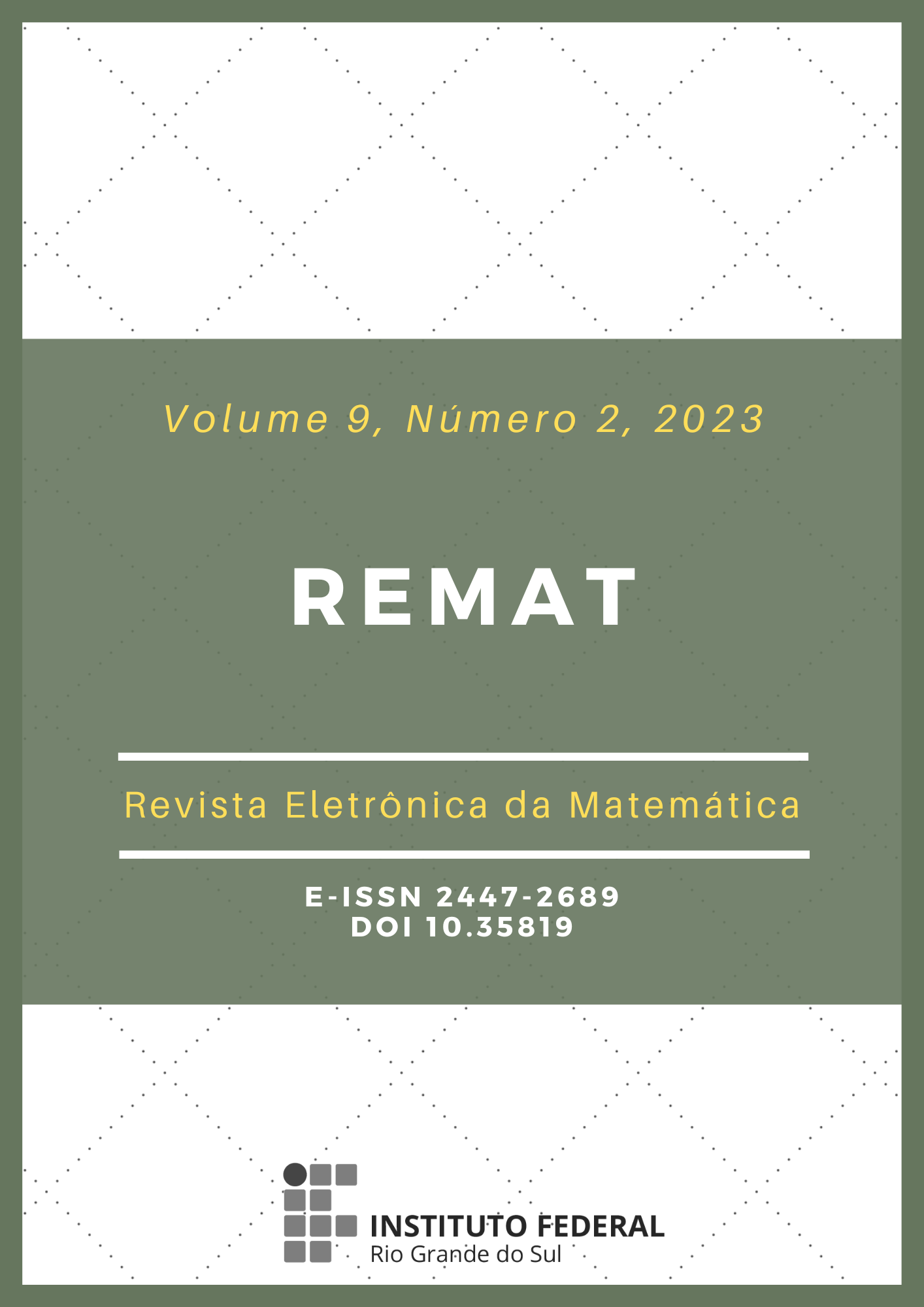Study of Ramsey's number R(3,10): analysis of graphs on 40 vertices
DOI:
https://doi.org/10.35819/remat2023v9i2id6424Keywords:
graph theory, bicolor graphs, Ramsey numbers, click, independent setAbstract
The Ramsey number R(k,l) is the smallest integer n such that there is no (k,l,n,e)-graph, where a (k,l,n,e)-graph denotes a graph G with n vertices and e edges and with C(G)<k e I(G)<l, where C(G) denotes the largest clique in G and I(G) denotes the largest independent set in G. The graph theory gave rise to extensive research, because no matter how simple the definition is, calculating the Ramsey numbers is an arduous task and few are known. Exoo (1989), Goedgebeur and Radziszowski (2013) showed that 40 <= R(3,10) <= 42. Thus, in this article, we will expose propositions that will be useful in the calculation of this Ramsey number. Based on the ideas of Grinstead and Roberts (1982) and Cariolaro (2007), properties and characteristics will be displayed for a bicolored graph of order 40, such that G is free of triangles, that is, C(G)<3, and does not have an independent set of order 10, that is, I(G)<10. We will show, for example, that given G = (V,E) a graph of order 40, such that C(G) < 3 and I(G) < 10, then, for every vertex v in V, we have that 4 <= deg(v) <= 9. Finally, we emphasize that the unpublished results obtained by the authors, in a research project developed at IFRS, Campus Alvorada, are found in Section 4.
Downloads
References
AZEVEDO, D. S.; MEDEIROS, J. F. de; ZITZKE, D. C.; PEREIRA, R. R.; BERNARDINO, L. S. Análise de um método de coloração no estudo do número de Ramsey R(3,10). REMAT: Revista Eletrônica da Matemática, Bento Gonçalves, RS, v. 8, n. 1, p. e3001, 2022. DOI: https://doi.org/10.35819/remat2022v8i1id4985.
CARIOLARO, D. On the Ramsey number R(3,6). Australasian Journal of Combinactorics, v. 37, p. 301-304, 2007. Disponível em: https://ajc.maths.uq.edu.au/pdf/37/ajc_v37_p301.pdf. Acesso em: 17 out. 2023.
DIESTEL, R. Graph Theory. 2. ed. eletronic edition. New York: Springer-Verlag, 2000.
EXOO, G. On Two Classical Ramsey Numbers of the Form R(3, n). SIAM Journal on Discrete Mathematics, v. 2, n. 4, p. 488-490, 1989. DOI: https://doi.org/10.1137/0402043.
GOEDGEBEUR, J.; RADZISZOWSKI, S. P. New Computational Upper Bounds for Ramsey Numbers R(3,k). Electronic Journal of Combinactorics, v. 20, n. 1, 2013. DOI: https://doi.org/10.37236/2824.
GREENWOOD, R. E.; GLEASON, A. M. Combinatorial Relations and Chromatic Graphs. Canadian Journal of Mathematics, v. 7, p. 1-7, 1955. DOI: https://doi.org/10.4153/CJM-1955-001-4.
GRINSTEAD, C. M.; ROBERTS, S. M. On the Ramsey numbers R(3,8) and R(3,9). Journal of Combinatorial Theory, v. 33, p. 27-51, 1982.
Radziszowski, S. Small Ramsey Numbers. The Electronic Journal of Combinatorics. 1994. Revisão de 2021. DOI: https://doi.org/10.37236/21.
RAMSEY, F. P. On a Problem of Formal Logic. Proceedings of the London Mathematical Society, v. 2, n. 30, p. 264-286, 1930. DOI: https://doi.org/10.1112/plms/s2-30.1.264.
SANCHES, J. Ferramentas probabilísticas aplicadas a problemas de coloração em grafos. Orientador: Carlos Hoppen. 2016. 151 f. Tese (Doutorado em Matemática Aplicada) – Universidade Federal do Rio Grande do Sul, Porto Alegre, dez. 2016. Disponível em: http://hdl.handle.net/10183/153219. Acesso em: 19 out. 2023.
SANCHES, J. Números de Ramsey em grafos multipartidos. Orientador: Emerson Luiz do Monte Carmelo. 2013. Dissertação (Mestrado em Matemática Aplicada) – Universidade Estadual de Maringá, Maringá, 2013.
SPENCER, J. H. Ramsey's Theorem: A New Lower Bound. Journal of Combinatorial Theory, Série A, v. 18, n. 1, p. 108-115, 1975. DOI: https://doi.org/10.1016/0097-3165(75)90071-0.
Downloads
Published
Issue
Section
License
Copyright (c) 2023 REMAT: Revista Eletrônica da Matemática

This work is licensed under a Creative Commons Attribution 4.0 International License.
REMAT retains the copyright of published articles, having the right to first publication of the work, mention of first publication in the journal in other published media and distribution of parts or of the work as a whole in order to promote the magazine.
This is an open access journal, which means that all content is available free of charge, at no cost to the user or his institution. Users are permitted to read, download, copy, distribute, print, search or link the full texts of the articles, or use them for any other legal purpose, without requesting prior permission from the magazine or the author. This statement is in accordance with the BOAI definition of open access.













 https://orcid.org/0000-0002-0893-7426
https://orcid.org/0000-0002-0893-7426


















